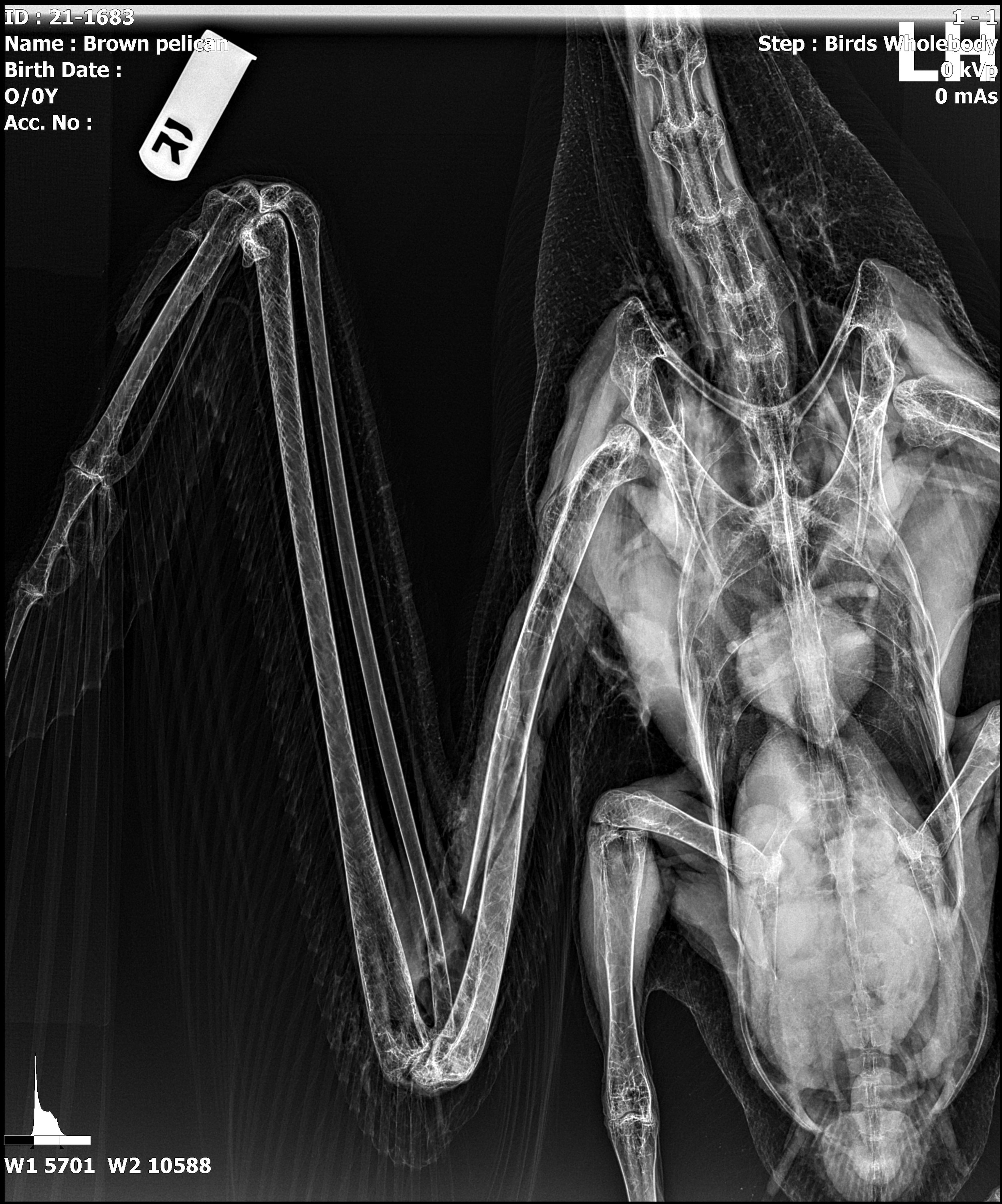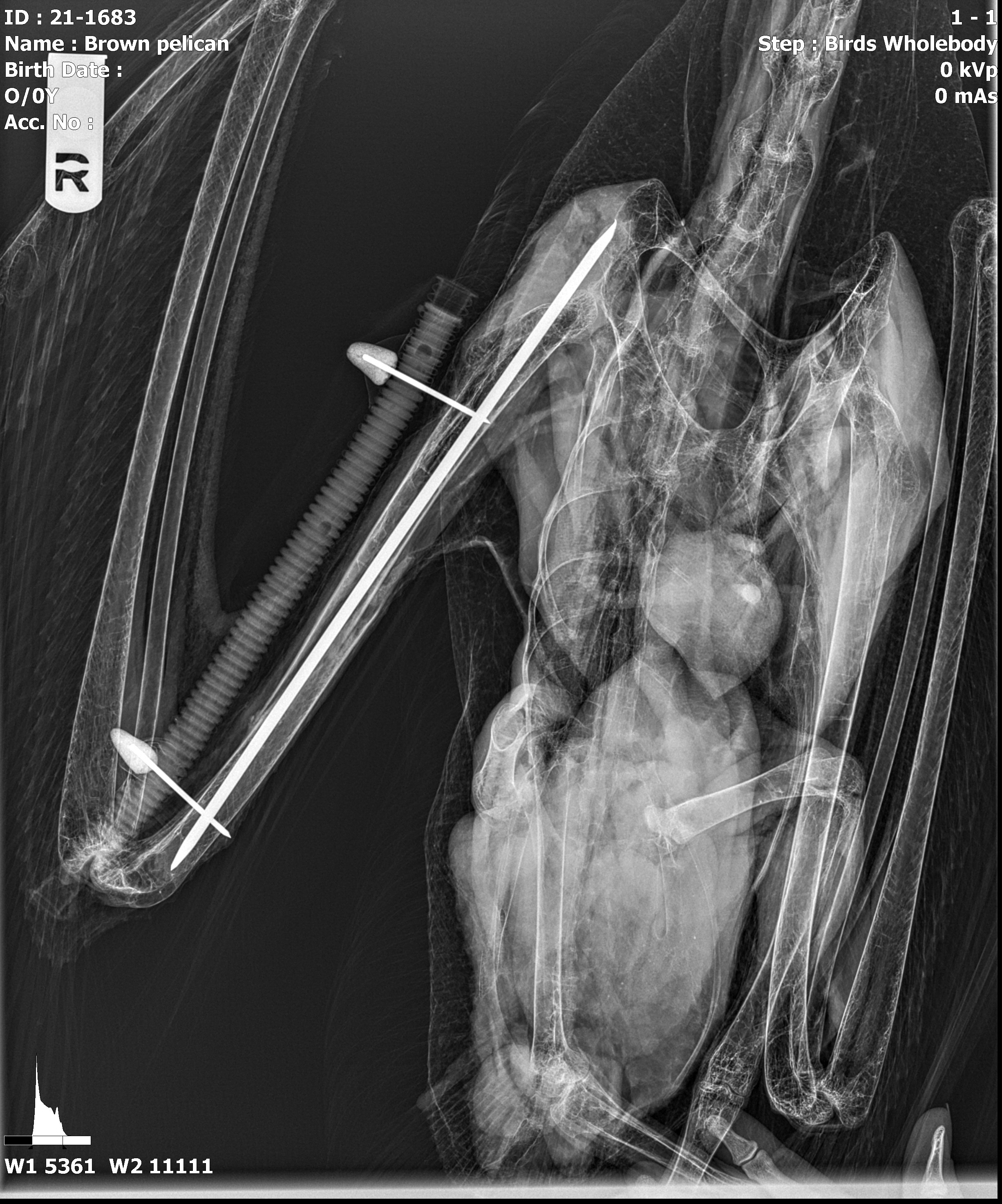Written by: Amanda Burke, Wildlife Rehabilitator & Intern Coordinator
X-Ray of Patient# 1683’s right wing fracture
In September 2021, a Brown Pelican was admitted to Pelican Harbor with a fractured humerus bone in its right wing. Orthopedic surgery was performed where multiple pins were placed in cross sections across the bone to stabilize the fracture and enable the bones to fuse properly. In addition to the pins, an external fixator device was also placed at the site. This involves a piece of acrylic encased in a tube that is placed on the outside of the wing to keep the pins in place and limit rotation so the bone heals properly. This type of surgery is a huge undertaking for wounded animals, as the stress of going under anesthesia for long periods of time can cause adverse reactions. Thankfully, patient #21-1683 made it through the surgery successfully. What followed was 6 months of hard work on the part of not just the rehab team but the pelican himself. Every day he received physical therapy and medications to aid in his healing. We had to ensure he would have a full range of motion in his wing so that he could fly, hunt for food, and most importantly, live and thrive on his own in the wild.
X-Ray of Patient# 1683’s external fixator device
In March 2022, 6 months after its initial intake, release day finally came for our pelican. He had completed his physical therapy and proved to us he could fly and hunt on his own despite a persistent but benign wing droop. This is the happiest day for our rehabilitation team because it’s the culmination of all our worry and hard work. Undoubtedly, it’s the best day for the animal too! He was released with another pelican on our property here in Miami, where they flew off together, and we considered it another successful release.
However, over the next couple of months, we got numerous calls from people worried that the pelican was unable to fly due to his wing droop. After some time monitoring him and multiple visits to the jetty, it was determined that he was not thriving in the wild due to consistent human intervention and he was brought back to PHSS for further evaluation. We decided to relocate him to an area that would not have the amount of human interaction he had in his previous release area.
Patient# 1683 with injured right wing
Then, we started getting calls about Facebook videos being posted of people interacting with him in various ways around the Haulover Jetty area–touching him, petting him, feeding him fish, and attempting to “help” him even though he was more than capable of taking care of himself. Despite numerous attempts of release at different locations, the pelican kept returning to the Haulover Jetty, where he had seemingly become irreversibly accustomed to being fed by humans. Because of this, he was deemed unreleasable by our veterinarians and had to be permanently placed at a sanctuary, where he will live out the rest of his life in captivity.
Please remember when you see a wild animal, they are just that– wild. Always be sure to keep your distance, and never feed wildlife. In order to thrive and survive, they need to keep their wild instincts. When animals become habituated to humans, they no longer want to look for their own food and instead spend their time in heavily populated areas. In the case of pelicans specifically, when they start to see humans as a source of food, they end up getting hooked because they hang out in fishing areas. This results in various injuries and entanglement, sometimes ingesting the hooks themselves which can ultimately result in death. Additionally, people feed them food that isn’t meant for them which can get stuck in their throat or make its way to their stomach where it then destroys their intestinal tract because it is too big for what their bodies are supposed to eat.
The best way to be a friend to wild animals is to stay as far away as possible and let them live their lives without our influence. As always, refrain from feeding, holding, or petting wild animals, no matter how friendly they may seem.






